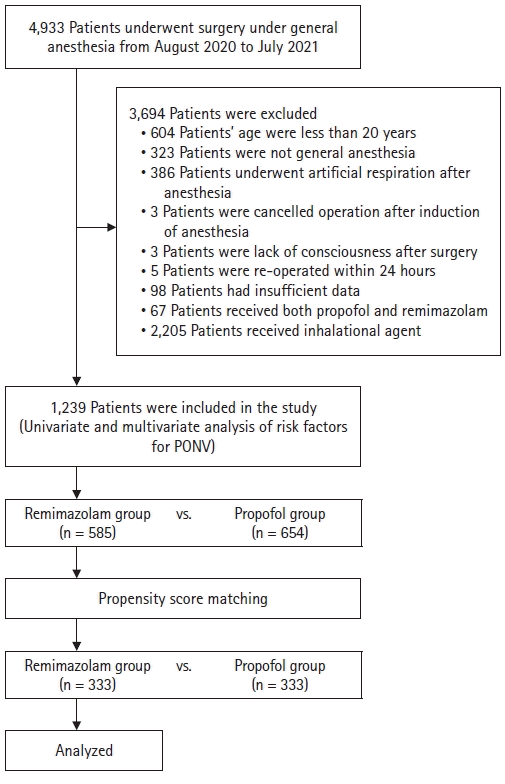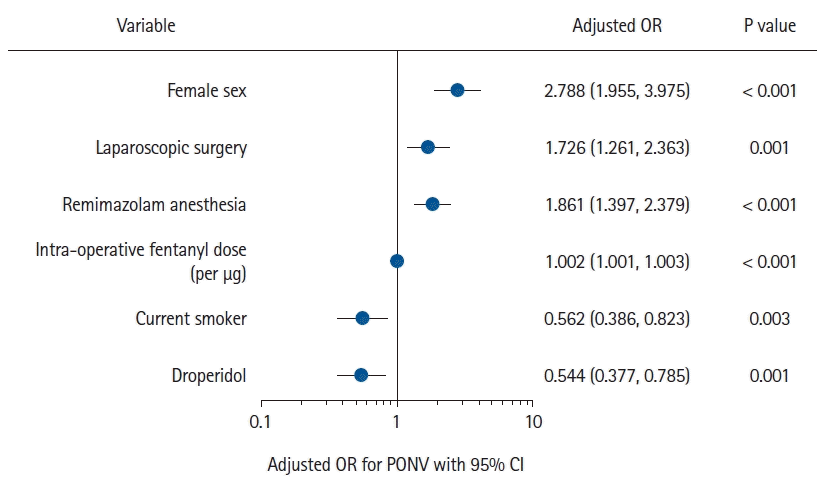1. Gan TJ, Belani KG, Bergese S, Chung F, Diemunsch P, Habib AS, et al. Fourth consensus guidelines for the management of postoperative nausea and vomiting. Anesth Analg. 2020; 131:411–48.
2. Gan TJ. Risk factors for postoperative nausea and vomiting. Anesth Analg. 2006; 102:1884–98.
3. Apfel CC, Heidrich FM, Jukar-Rao S, Jalota L, Hornuss C, Whelan RP, et al. Evidence-based analysis of risk factors for postoperative nausea and vomiting. Br J Anaesth. 2012; 109:742–53.
4. Steib A, Freys G, Jochum D, Ravanello J, Schaal JC, Otteni JC. Recovery from total intravenous anaesthesia. Propofol versus midazolam-flumazenil. Acta Anaesthesiol Scand. 1990; 34:632–5.
5. Liu T, Lai T, Chen J, Lu Y, He F, Chen Y, et al. Effect of remimazolam induction on hemodynamics in patients undergoing valve replacement surgery: a randomized, double-blind, controlled trial. Pharmacol Res Perspect. 2021; 9:e00851.
6. Doi M, Morita K, Takeda J, Sakamoto A, Yamakage M, Suzuki T. Efficacy and safety of remimazolam versus propofol for general anesthesia: a multicenter, single-blind, randomized, parallel-group, phase IIb/III trial. J Anesth. 2020; 34:543–53.
7. Kampmeier T, Rehberg S, Omar Alsaleh AJ, Schraag S, Pham J, Westphal M. Cost-effectiveness of propofol (diprivan) versus inhalational anesthetics to maintain general anesthesia in noncardiac surgery in the United States. Value Health. 2021; 24:939–47.
8. Morino R, Ozaki M, Nagata O, Yokota M. Incidence of and risk factors for postoperative nausea and vomiting at a Japanese cancer center: first large-scale study in Japan. J Anesth. 2013; 27:18–24.
9. Mauermann E, Clamer D, Ruppen W, Bandschapp O. Association between intra-operative fentanyl dosing and postoperative nausea/vomiting and pain: a prospective cohort study. Eur J Anaesthesiol. 2019; 36:871–80.
10. East JM, Mitchell DI. Emergency open cholecystectomy is associated with markedly lower incidence of postoperative nausea and vomiting (PONV) than elective open cholecystectomy: a retrospective cohort study. BMC Surg. 2010; 10:6.
11. Hvarfner A, Hammas B, Thörn SE, Wattwil M. The influence of propofol on vomiting induced by apomorphine. Anesth Analg. 1995; 80:967–9.
12. Grant MC, Kim J, Page AJ, Hobson D, Wick E, Wu CL. The effect of intravenous midazolam on postoperative nausea and vomiting: a meta-analysis. Anesth Analg. 2016; 122:656–63.
13. Kilpatrick GJ, McIntyre MS, Cox RF, Stafford JA, Pacofsky GJ, Lovell GG, et al. CNS 7056: a novel ultra-short-acting benzodiazepine. Anesthesiology. 2007; 107:60–6.
14. Weibel S, Rücker G, Eberhart LH, Pace NL, Hartl HM, Jordan OL, et al. Drugs for preventing postoperative nausea and vomiting in adults after general anaesthesia: a network meta-analysis. Cochrane Database Syst Rev. 2020; 10:CD012859.
15. De Oliveira GS Jr, Castro-Alves LJ, Ahmad S, Kendall MC, McCarthy RJ. Dexamethasone to prevent postoperative nausea and vomiting: an updated meta-analysis of randomized controlled trials. Anesth Analg. 2013; 116:58–74.
16. Bisgaard T, Klarskov B, Kehlet H, Rosenberg J. Preoperative dexamethasone improves surgical outcome after laparoscopic cholecystectomy: a randomized double-blind placebo-controlled trial. Ann Surg. 2003; 238:651–60.
17. Mao Y, Guo J, Yuan J, Zhao E, Yang J. Quality of recovery after general anesthesia with remimazolam in patients’ undergoing urologic surgery: a randomized controlled trial comparing remimazolam with propofol. Drug Des Devel Ther. 2022; 16:1199–209.
22. Jun IJ. Effect of remimazolam on postoperative nausea and vomiting in patients undergoing laparoscopic cholecystectomy [Internet]. Bethesda (MD): U.S. National Library of Medicine; 2022 Jun [cited 2022 Jul 7]. Available from
https://clinicaltrials.gov/ct2/show/NCT05439057.
23. Hari Y, Satomi S, Murakami C, Narasaki S, Morio A, Kato T, et al. Remimazolam decreased the incidence of early postoperative nausea and vomiting compared to desflurane after laparoscopic gynecological surgery. J Anesth. 2022; 36:265–9.
24. Song SW, Jang YN, Yoon MW, Jeon YG. Quality of recovery in patients administered remimazolam versus those administered an inhalant agent for the maintenance of general anesthesia: a randomized control trial. BMC Anesthesiol. 2022; 22:226.
25. Mazzotta E, Villalobos-Hernandez EC, Fiorda-Diaz J, Harzman A, Christofi FL. Postoperative ileus and postoperative gastrointestinal tract dysfunction: pathogenic mechanisms and novel treatment strategies beyond colorectal enhanced recovery after surgery protocols. Front Pharmacol. 2020; 11:583422.
26. Treschan TA, Zimmer C, Nass C, Stegen B, Esser J, Peters J. Inspired oxygen fraction of 0.8 does not attenuate postoperative nausea and vomiting after strabismus surgery. Anesthesiology. 2005; 103:6–10.






 PDF
PDF Citation
Citation Print
Print



 XML Download
XML Download